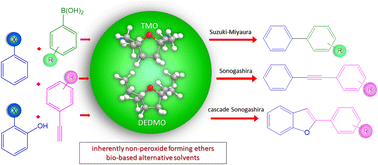Application of hindered ether solvents for palladium catalyzed Suzuki–Miyaura, Sonogashira and cascade Sonogashira cross-coupling reactions†
Abstract
Cross-coupling and cascade reactions typically rely on unsustainable and toxic volatile organic solvents. 2,2,5,5-Tetramethyloxolane (TMO) and 2,5-diethyl-2,5-dimethyloxolane (DEDMO) are both inherently non-peroxide forming ethers, and have been used in this work as effective, more sustainable, and potentially bio-based alternative solvents for Suzuki–Miyaura and Sonogashira reactions. Suzuki–Miyaura reactions demonstrated good yields for a range of substrates, 71–89% in TMO and 63–92% in DEDMO. In addition, a Sonogashira reaction exhibited the excellent yields of 85–99% performed in TMO, which was significantly higher than traditional volatile organic solvents, THF or toluene, and higher than those reported for another non-peroxide forming ether, namely eucalyptol. Cascade Sonogashira reactions utilizing a simple annulation methodology were particularly effective in TMO. Furthermore, a green metric assessment confirmed that the methodology employing TMO was more sustainable and greener than the traditional solvents THF and toluene, thereby demonstrating the promise of TMO as an alternative solvent for Pd-catalyzed cross-coupling reactions.



 Please wait while we load your content...
Please wait while we load your content...